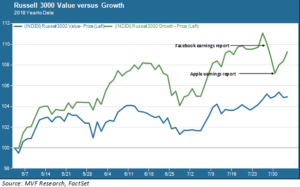
Sentiment travels quickly in the hyperkinetic world of the global capital markets. Just a week ago, the talk of the town was all about the Great Rotation. After weeks, months…nay, years! of underperformance, value stocks looked poised to unseat the great megatrend in growth stocks.
Remember one week ago? Facebook tanked as investors found reasons aplenty not to like the company’s earnings report, which suggested that stupendous revenue growth in the mid-40s would turn into not-quite-as-stupendous revenue growth in the mid-20s, and fat profit margins in the mid-40s would become somewhat less obese (though still hefty) profit margins in the low 30s. Facebook’s woes came on the heels of an earlier subdued outlook by Netflix and was followed by more downbeat headlines from Twitter (apparently being the official platform for the communication of US government policy doesn’t add much in the way of monetary value…). Suddenly FAANG nation (and its fellow travelers like Twitter) was in trouble! Rotation to value in three…two…one…
Blessed Be The Fruit
And then there was Apple, and the $1 trillion market capitalization that swiftly dispatched away all that talk of a Great Rotation from growth to value. As the chart below shows, growth (in green) has recovered quite nicely, thank you, in the space of the past three days.

The only thing financial pundits love more than talking about a market rotation is talking about big round numbers, and they don’t get bigger or rounder than $1 trillion. Value rotation, we hardly knew ye!
The Unsolved Mystery of Value Investing
Now, the fact that we have to bide our time for awhile longer before value stocks come back into favor does not do anything to solve the big mystery of what, in the name of all that is good and wholesome, ever happened to value stocks in the first place. After all, the “value effect” is supposed to be one of the fixtures of long term investing. The value effect holds that investing in stocks whose market price is lower than their fundamental value pays off. Over time, you are more likely to perform well by buying and holding out-of-favor names that are mispriced by the market than you are by getting into a hot growth name that everyone else is chasing.
The logic behind the value effect seems impeccably tight. But the numbers tell a different story. Over the last thirty years, the value segment of the Russell 3000 stock index, a broad measure of US stocks, actually underperformed the broader index. Not by much – the Russell 3000 Value returned an average annual 10.38 percent compared to 10.53 percent for the Russell 3000. But still – that’s a 30 year span of time, nearly one third of a century. And the numbers don’t improve. The value index underperformed growth over most time periods since then, with the gap between them increasing. Over the last five years a growth investor outperformed her value counterpart by more than 5 percent on an annual average basis.
The Software That Ate the World
The value conundrum is occupying quite a bit of our research brainpower here at MV Financial and we plan to come out with a more in-depth research piece on the topic some time in the coming weeks. One way of looking at the mystery is supplied by Marc Andreessen, the Silicon Valley venture capitalist and founder of Netscape (hi, kids! That was a browser we used back in the days when we used to dial into our AOL accounts. See “hissing modems”…). Back in 2011 Andreessen penned an article called “Why Software Is Eating the World.” The premise was that software platforms were encroaching into the central business value propositions of practically every industry sector, with the lion’s share of rewards falling to those companies most adept and developing and deploying technology solutions for their markets.
At the time Andreessen’s article was dismissed by many as so much Valley technobabble, but it has stood the test of time. Just look at what happens on any given day when, say, Amazon threatens to enter the retail pharmaceutical business or buys Whole Foods. Competitive industry dynamics these days do appear to be about little else than the deft execution of hard-to-imitate software platforms.
If Andreessen’s thesis is behind the growth stock megatrend, then investors will not be too happy when the FAANG sharks and their extended court of growth stock pilot fish do run out of upside. The result may be less an orderly reversion to mean while value stocks run for a while, and more a winding down of this historically long bull market. We are not suggesting that this is imminent, but it does bear watching. Meanwhile, detective work on the Case of the Missing Value Effect will continue apace.